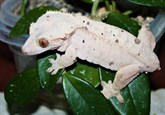Breeding Project :
Orange brindle dalmatian X Partial Pin dark olive flame dalmatian
|
|


|
Vitals
|
|
Total Eggs:
|
13
|
|
Fertile Eggs:
|
12
|
|
Infertile Eggs:
|
1
|
|
Questionable:
|
--
|
|
Slugs:
|
--
|
|
Hatched:
|
10
|
|
Incubation:
|
Combination
|
|
Date Laid:
|
2/17/2017
|
|
Date Hatched:
|
--
|
|
Date Closed:
|
10/24/2017
|
|
|
|
Overview
Our female orange brindle dalmatian has been housed with the male partial pin stripe dark olive flame dalmatian now for more than two months. These two were separated back around May and now each have their own large enclosure. We currently have two eggs incubating. These eggs are all incubating in the dirt their mother dug them into at 78 degree F temperature in an incubator. Our room temperature sits around 73-75 degrees Fahrenheit in the warm months. Right now in mid Fall our room temperatures are sitting around 60-68 degrees F.
First set of eggs laid 2/17/2017___Second set of eggs laid 3/19/2017___Third set of eggs laid 4/18/2017.
Paper documentation was accidentally destroyed by the cat.... So unfortunately I cannot add the correct dates for eggs hatched and eggs layed till now 8/28/2017. Sorry about that meant to get everything loaded into here again soon before that happened.
The first set of eggs from 2/17/2017 hatched out April 26th and 27th 2017. A 65 day incubation period.
-two eggs hatched 8/14/2017 (now unknown lay date was probably around 6/20 to 6/27 2017)
-two fertile candled eggs laid 8/28/2017
-two eggs with now unknown lay date still incubating as of 8/28/2017 (probably laid around 7/20 to 7/30 2017)
-egg laid around 7/20-7/30 2017 hatched on 9/22/2017. The second egg died and molded 9/19/2017.
-the two fertile candled eggs laid 8/28/2017 became a bit too dry and dimpled around 10/19/2017. Efforts were made to bring their humidity back up and plump the eggs back out again as it was only a small dimple.
-two fertile candled eggs laid 8/28/2017 began to mold and smell badly on 10/24/2017. They were candled one last time and with no movement were cut open revealing dead hatchlings that had just about been ready to hatch.
**The first half of the last two eggs incubation had been in 80-82 degree F. temperatures while the last half of their incubation was lowered slowly to 76-78 degrees Fahrenheit in order to match the same conditions that numbers 6 and 7 (the bright ruby red babies) had in an attempt to see if incubation is what created their unique red coloring. Photos of the babies extracted from their eggs will be uploaded, but they had no physical deformities this time, and appeared to be the same bright ruby red colors as numbers 6 and 7 furthering my theory that high or low incubation temperatures influence more than just crest size and length, but also perhaps the color of geckos. Having four develop the same coloring is not coincidence under those conditions. Since these were the last two eggs of this year we will have to continue these experiments next breeding season.
Events & Tracking
|
Animal
|
Title
|
Type
|
Date
|

|
Egg hatched
|
Comments
|
4/26/2017
|

|
Second egg hatched
|
Comments
|
4/27/2017
|

|
Removed [FG_Fl] Flint
|
Removed Male
|
4/27/2017
|

|
Copulation with [FG_Fl] Flint
|
Observed Copulation
|
4/27/2017
|
Breeding Photo Gallery

1st baby
|

3rd baby
|

5th baby
|

7th baby
|

9th baby
|

2nd baby
|

4th baby
|

6th baby
|

8th baby
|

Narillo X Flint Family Tree +2017 hatchlings
|
|
|